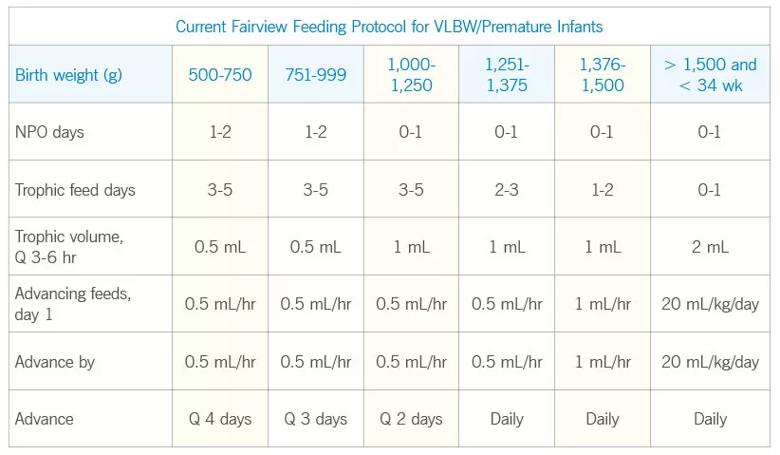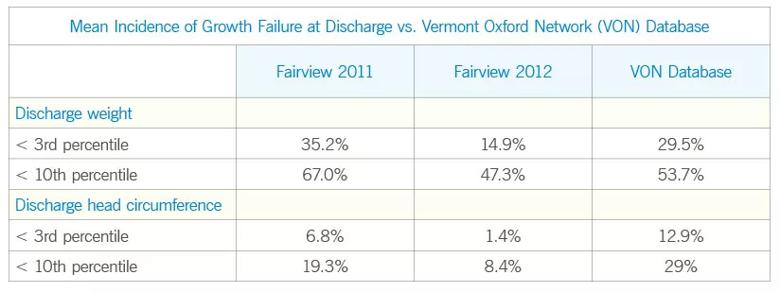Fairview slow-advance feeding protocol reduces risk of NEC

By Taylor Rice, RD, and Jalal Abu-Shaweesh, MD
Cleveland Clinic is a non-profit academic medical center. Advertising on our site helps support our mission. We do not endorse non-Cleveland Clinic products or services. Policy
Over the past 30 years, Cleveland Clinic’s Fairview Hospital — home to one of three level III NICUs in the Cleveland Clinic Children’s network — has maintained a very low incidence of necrotizing enterocolitis (NEC) in infants with very low birth weight (VLBW). Specifically, among 1,992 VLBW infants admitted during this period, the incidence of NEC has been 0.6 percent, ranging from 0 to 2 percent annually. This compares favorably to the 5.6 percent mean incidence reported in the Vermont Oxford Network database over the past five years.
This low risk of NEC has been attributed to a distinctive feeding strategy, which we call the Fairview slow-advance feeding protocol, instituted at Fairview Hospital in 1986. As our Fairview Hospital colleagues reported in a 20-year experience review published nearly a decade ago,1 the protocol differed from previously published protocols by providing late-onset, slow, continuous-drip enteral feeding.
This protocol was shown to decrease the incidence of NEC without an increase in long-term morbidity;1 however, use of the protocol was associated with an adverse effect on growth. Between 2006 and 2010, the incidence of VLBW infants with discharge weight below the 10th percentile was 70 to 80 percent annually. Moreover, the incidence of a head circumference below the 10th percentile at discharge was 30 to 45 percent during the same period.
In response to these findings, in 2012 we evaluated feeding tolerance, growth rate and short-term outcomes in 85 VLBW infants admitted to the Fairview NICU during 2011. Average gestational age was 28.7 ± 2.1 weeks; average birth weight was 1,090 ± 279 g. Feeds were started at day of life 3.5 ± 2.6, and full fortified feeds were achieved by 24.1 ± 8.8 days. The most impressive finding was that once started, feeds were interrupted for only 0.7 ± 1.6 days, signifying dramatic feeding tolerance. Infants regained their birth weight by 10.6 ± 4.1 days. The major factor associated with accelerated growth rate was reaching full fortified feeds. Whereas the growth rate was 8.2 ± 5.9 g/day before full fortified feeds were reached, it was a significantly higher 25.8 ± 6 g/day afterward (P < .001).
Complications traditionally associated with slow feedings — including cholestasis, bone disease and sepsis, including central line-associated bloodstream infections (CLABSIs) — were low. Cholestasis (direct bilirubin > 1 mg/dL) occurred in nine infants and resolved in all by discharge, while six infants had a maximum alkaline phosphatase level above 500 U/L. The incidence of any late infection was 2.2 percent, which compares favorably to the 14.2 percent in the Vermont Oxford Network database. The incidence of CLABSIs was 0.7 per 1,000 line days.
We concluded that the slow-advance feeding protocol is effective in preventing NEC without increased short-term complications but is associated with poor growth. This led to the first revision of our protocol in 20 years, which was adopted with some modification by all Cleveland Clinic NICUs. Table 1 summarizes our current feeding protocol.

To reduce rates of growth failure at discharge, we introduced an aggressive early nutrition initiative in VLBW infants that consisted of starting parenteral nutrition with protein intake of 3.2 g/kg/day in the first day of life, followed gradually by maintaining parenteral protein intake of at least 3 g/kg/day in the first week.
We then evaluated the effect of this initiative on growth parameters at discharge in 70 VLBW infants. There was a gradual decrease in the incidence of infants with discharge weight and head circumference below the 10th and 3rd percentiles between 2011 (before and during implementation of the aggressive early nutrition initiative) and 2012 (after the initiative), and also as compared with historical data (Table 2).

Average protein intake in the first week of life was found to be significantly lower in infants with head circumference below the 10th percentile at discharge relative to those with circumference above the 10th percentile: 2.9 ± 0.5 vs. 3.2 ± 0.4 g/kg/day (P < .05). While higher protein intake was associated with significantly higher blood urea nitrogen at 24 hours (28 ± 10 vs. 18 ± 6 mg/dL; P < .01), the difference disappeared after 24 hours and no infants developed long-term renal insufficiency. We concluded that higher protein intake in the first week of life is associated with better head growth at discharge in VLBW infants.
We noted, however, that the difference between groups could have been related to changes in intake beyond the first week of life. We therefore evaluated the effect of nutritional factors throughout hospitalization on growth parameters at discharge in 103 VLBW infants admitted to Cleveland Clinic’s regional NICUs between January 2013 and May 2014. Median [Q1, Q3] birth weight was 1,189 [900, 1,345] g, and median gestational age was 29 [28, 31] weeks.
The incidence of weight and head circumference below the 10th percentile was 22.3 percent and 18.4 percent at birth and 41.7 percent and 15.5 percent at discharge, respectively. Head circumference was categorized into six percentile ranges (< 3rd, 3rd-10th, 10th-50th, 50th-90th, 90th-97th, and > 97th), and the change in category from birth to discharge was computed. For example, a change from category 4 (50th-90th) to category 2 (3rd-10th) represented a category change of –2. Head circumference percentile category at discharge was significantly and positively associated with:
At discharge, 50 percent of babies with head circumference below the 10th percentile had fallen in percentile category since birth. Notably, average protein intake > 3.5 g/kg/day was associated with improved percentile category at discharge compared with intake < 3.5 g/kg/day (P = .016). After adjusting for head circumference at birth, each 1 g/kg/day increase in protein intake in the first week of life was associated with a 0.41 increase in head circumference percentile category. Caloric intake had no effect on percentile category change.
In summary, the slow-advance feeding protocol as used across Cleveland Clinic Children’s is well tolerated and associated with very low incidence of NEC in VLBW infants. While it is associated with poor growth, especially before full fortified feeds are achieved, growth can be improved by optimizing parenteral nutritional intake. Protein intake throughout hospitalization — but especially during the first week of life — should be emphasized to promote brain growth and prevent head growth failure.
Ms. Rice is a registered dietitian in the Department of Pediatric Nutrition Support.
Dr. Abu-Shaweesh is Chair of the Department of Pediatrics at Cleveland Clinic’s Fairview Hospital and a staff physician in the Department of Neonatology.

Cleveland Clinic physicians offer their insights

Increasing support for breastfeeding patients

Program has facilitated nearly 300 consults across 25 departments in less than a year

Though completely preventable, lead poisoning remains a public health threat

Differences in infection rates, management, outcomes and transmission

Helps patients visualize proper tongue placement

On the need for coordinated care